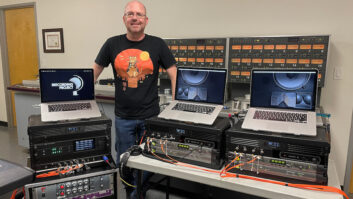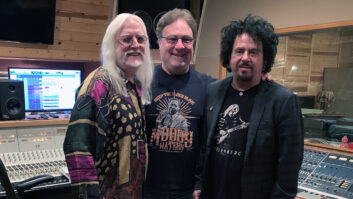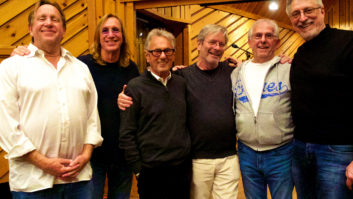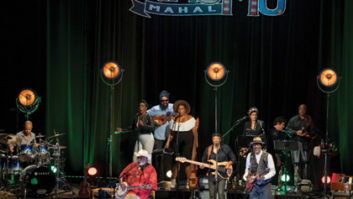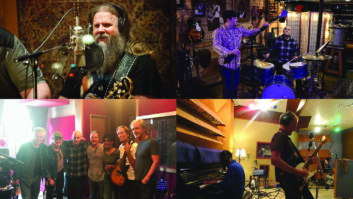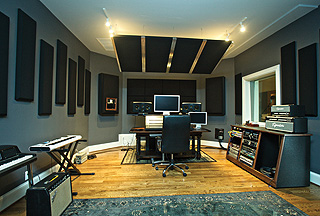
Keb Mo, it turns out, is a hands-on guy. And his engineer, John Schirmer, is something of a jack-of-all-audio-trades. So when they decided to leave L.A. for Nashville in 2010, and the original plan to buy a house with a studio already in place fell through, they decided to build their own. Two, actually, with almost identical technology complements.

Engineer John Schirmer (left) and Keb Mo
Photos: Meghan Aileen Photography
The first to go up was Schirmer’s Twelve Tone Studios, at his home in Franklin, where they did some recutting of vocals and guitars during the mixing for the August release of The Reflection. It was followed by Keb Mo’s Stu Stu Studios, albeit on a slightly larger scale, also in Franklin. “Kevin and his family fell in love with this house,” Schirmer recalls, “and when we did a walk-through, we looked at this 2,900-square-foot basement, with a three-car garage, an office, a big open rec room. Lots of space. And 14-foot ceilings! There were lots of possibilities. A great blank canvas.”

But there was also a budget, which, while not low-cost was certainly not extravagant. So while quick to praise the contributions of a good studio designer, they decided to put their money into materials and construction and go D.I.Y. Schirmer read Jeff Cooper’s Building a Recording Studio, along with every article he could find online, and agreed to supervise the build-out. They hired the contractor on the original house, who had built other home studios in town. Bill “Hatchett” Story installed a separate electrical system. And they hired Michael Rhoads of Skinny Fish Audio to wire the place professionally, with input panels placed in every space, including closets, and video and audio ties to the living room upstairs for the grand piano and a live, open, wood-and-glass living room sound.
Schirmer hooked up with Keb Mo in 2006 while touring with Bonnie Raitt as P.A. systems tech. The two hit it off, and over the ensuing years he’s served as tour manager, production manager, live engineer, studio engineer and now studio designer. For the artist’s space, they decided early on to float the floors on rubber isolators as isolation was paramount and they were rebuilding within an existing portion of the garage. And they knew they needed to drop the ceiling by two feet and blow a lot of insulation into the walls. Once construction was under way, he turned to surface treatments to fine-tune the monitoring environment.
“I’ve known Peter Janis for a while now, and when I started working with Keb, I contacted him for some of his Radial J48 DI units,” Schirmer says. “Kevin [aka, Keb Mo] has five or six guitars onstage for his acoustic shows, and it can get like a rat’s nest of cables up there. So Peter helped put together a more functional setup using the Radial JD7, guitar splitter and a rack filled with Radial J48s, and eliminated the rat’s nest. We have been friends ever since.
“Then while we were working on the studio, I realized that Peter also owns Primacoustics,” he recalls. “I sat down with his guy in Vancouver, Jay Porter. I drew out all the rooms with all the exact dimensions, floor to ceiling, wall to wall, interior and exterior. I sent them to him and he sent back some diagrams. We made some adjustments and I sent them back. He sent them back to me, and the next thing you know, we have four rooms all laid out and a tractor-trailer shows up at Keb’s house with all this material on pallets. Me and Keb’s guitar tech, Casey Wasner, went in there and put this stuff together in three days, looked and listened, and it turned out phenomenal. It cost me just under 15 grand as opposed to 70 grand. We’ve got a mixture of bass traps and diffusion and clouds in the control room, and it turned out very cool.
“The first thing we did entirely in the room, track and mix, was this four-song Christmas EP for Ryko,” he adds. “We would record real-time bounces back into Pro Tools, export the regions as files, burn CDs and listen in our cars, and it was exactly what we were hearing, so much so that we went in and did a couple of bonus acoustic tracks for The Reflection. We mastered them ourselves in the room because it was so true, and the record company loved them. Good monitoring, good clocking, good D-to-A conversion and some well-placed acoustic treatments, and it sounds phenomenal.”
Today, Schirmer and Keb Mo have near-mirror-image studios in their technology choices and their acoustic treatments, so that the vast amount of work—from the records to music for the weekly TV series Memphis Beat and Mike and Molly—can come out of either place, with the same expectations of quality for production. Avid Control|24 console, ADAM SX-3H monitoring, two full lockers full of microphones, including a Miktek C7 mic for vocals. Avid HD I/O, 192 and 96, and all of the same plug-ins. Plus outboard gear from Universal Audio, API, Grace, Avedis, Shadow Hills and Neve. They have been very busy, and with these two studios they can handle all of it.
Video: Keb Mo Recording in His Studio
